Besides famous sites of historic interest, Osaka has shopping malls and large-scale amusement facilities that have become new landmarks.
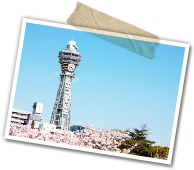
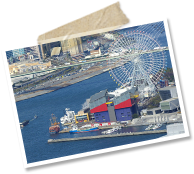
Osaka consists of a northern area, "Kita", southern area, "Minami", the area in between, "Naka", and a "Bay Area" which faces the ocean whilst still being a part of the city. There are unique spots to enjoy in each area.

There are actually many famous hot springs in metropolitan Osaka.
Experience the feeling of "iyashi" ("healing") at either a day trip hot spring in the city or surrounded by nature in an open-air bath whose water flows directly from the source...
After sightseeing to your heart's content, why not relax in one of Osaka's famous hot springs?
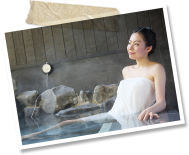

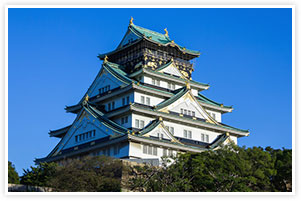
- Access
- Take the loop line from Osaka Station, alight at Osakajo Koen Station and walk for approx. 15 minutes.
- TEL
- +81-6-6941-3044
Construction of the impregnable and extravagant castle began in 1583 at the command of Hideyoshi Toyomi, the man who successfully unified the whole country. During Hideyoshi's lifetime the castle town of Osaka flourished as a center of politics and economics, but the castle was almost destroyed by Ieyashi Tokugawa in 1615, in the Osaka Natsu no Jin (Summer Siege of Osaka). The castle was subsequently reconstructed in 1629 under the Tokugawa shogunate government, but then lightning struck the castle three times in just 39 years and burnt down the main tower. The current castle tower was rebuilt in 1931 with funds collected from citizens, following a call for donations issued by the mayor at the time. The building is a history museum, and on the second floor of the main tower there is a popular corner where you can get your photo taken in period attire. (300 yen per person) A panorama of Osaka City can be viewed from the observation deck on the eighth floor of the castle tower. The castle tower is illuminated from sunset until midnight Osaka Castle Park is a popular place for hanami (picnicking under cherry trees) in the Kansai area. There are around 4,500 cherry trees and 1,250 plum trees.
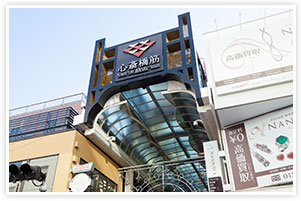
- Access
- Go out of either Exit No.5 or Exit No.6 of Shinsaibashi Station on the Subway Midosuji Line and walk north for a few minutes.
Shinsaibashi-suji runs north-south on the east side of Osaka's main street, Midosuji. Here you will find a historic shopping arcade which dates from the Edo period. The street is roughly 580 m long, and has around 160 stores, from long-established retailers, to outlets selling the latest teenage fashion items, to restaurants and cafes. Why not take a break in one of the cafes after window shopping along this lively Osaka street? The Shinsaibashi-suji area is considered to be one of Japan's representative entertainment districts, a fact which has earned it the nickname "The Ginza of the West". On the west side of Shinsaibashi Station there is Amerika-mura, a Mecca for fashion shoppers where you will find department stores, luxury brand outlets, the latest teen trends and chic cafes and restaurants.
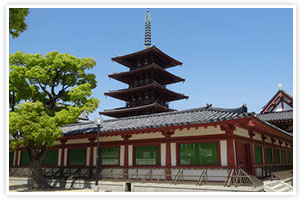
- Access
- Alight at Shitennoji-mae Yuhigaoka Station on the Subway Tanimachi Line and walk south for 5 minutes.
- TEL
- +81-6-6771-0066
Shitennoji Temple was built 1,400 years ago, in 593 AD. According to Nihonshoki (Chronicles of Japan), Prince Shotoku took Soga's side in the battle between Soga no Umako and Mononobe no Moriya. He carved four Shitenno statues and promised to build a temple to enshrine them in if his side won the battle. Soga's side won, and Prince Shotoku kept his promise and built the temple. The temple has been destroyed and reconstructed many times over the years, but the layout has remained the same since it was first built. The layout of the temple is called "Shitenno-ji Temple Garan Layout". The layout consists of an inner gate, a five-story pagoda, a kondo (main hall) and a lecture hall, all aligned from south to north and encircled by a hallway. It is one of the oldest architectural styles in Japan. The style originated in China and the Korean Peninsula in the 6th to 7th centuries, and tells us a lot about the culture of those regions. It is said that the temple also served as a guest house for welcoming envoys from the continent who arrived at the nearby port of Namba.
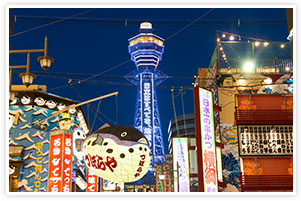
- Access
- Go out of Exit No.3 of Ebisu Station on the Subway Sakaisuji Line and walk south for 3 minutes.
Osaka Minami, where Tsutenkaku stands, is called "Shinsekai" ("New World"). The current tower is the second generation tower to stand on the site, following reconstruction of the first. It is 100 m tall. Shinsekai is a fun destination for all generations, with a zoo, movie theater and museum. The first Tsutenkaku was built at the end of Meiji period in 1912, on the site of the Expo, by local volunteers from the financial world who wanted to create "a place of entertainment suitable for the City of Osaka." Luna Park, which imitated an amusement park in New York, closed after only 11 years, but the 75-m-tall Tsutenkaku, built to imitate the Eiffel Tower in Paris, was an icon of Shinsekai until it was dismantled in 1943 because of a fire in the Ohashi-za Theater beneath the tower. The second Tsutenkaku, built in 1956, has a 360-degree observation deck on the fifth floor. The god of luck, Biriken welcomes you onto the observation deck. You can't tell if he's happy or angry, but Biriken is a popular figure, with his peculiar expression and cute pose.
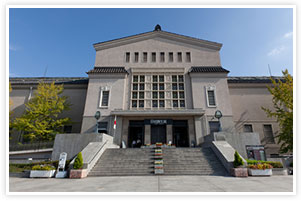
- Access
- From JR Tennoji Station, Tennoji Station on the Subway Tanimachi Line / Midosuji Line,
or Abenobashi Station on the Kintetsu Minami-Osaka Line, walk northwest for approx. 10 minutes (within Tennoji Park).
- TEL
- +81-6-6771-4874
Osaka City Museum of Fine Arts opened in May 1936. The museum stands in the Tennoji Park, on land which was originally the residence of the Sumitomo family. The land and gardens (Keitaku-en) were donated to Osaka City for the purpose of building the museum. More than 8,000 Japanese and Chinese paintings, sculptures and artifacts, either purchased or donated, are on permanent display, and pieces donated from temples and shrines are also occasionally exhibited. The collection includes many artworks that are designated important cultural assets. From time to time, various art organizations use the exhibition hall in the basement to hold exhibitions.
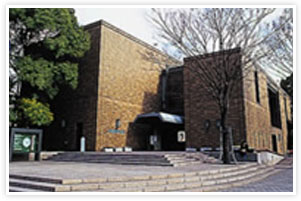
- Access
- Go out of Exit No. 1 of Yodoyabashi Station on the Subway Midosuji Line / Keihan Electric Railway and walk north east for approx. 5 minutes.
- TEL
- +81-6-6223-0055
The museum stands in Nakanoshima Park, which is located between the Tosa Horikawa and Dojima Rivers. The museum was established by Osaka City in November 1982 to commemorate the donation of the world-renowned “Ataka Collection” by the twenty-one companies of the Sumitomo Group. Among the collections of Korean and Chinese ceramics (the former of the Goryeo period) two pieces are registered as National Treasures and thirteen as Important Cultural Properties of Japan. Osaka is rightly proud to be home to "the most refined museum of ceramics in the world." The museum currently has about 2,000 pieces of art. The collection of Korean ceramics was significantly increased in 1999 when a Korean business man living in Japan, Rhee Byung-Chang, made generous donations, to the museum. This is the greatest collection of Korean ceramics outside of Korea. The park, filled with greenery and with a walking course, is a complete change from the business district on the other side of the river.

- Access
- Go out of Exit No. 1 of Yodoyabashi Station on the Subway Midosuji Line / Keihan Electric Railway and walk north east for approx. 5 minutes.
- TEL
- +81-6-6465-3000
Universal Studio Japan opened in March 2001 as the first Hollywood theme park outside the United States. Go under the large gate, and you will warp into the world of movies. The townscape from your favorite movie will be right before your eyes. The park is divided into nine zones where American towns and scenery from the movies are reproduced. Each area has restaurants, cafes and shops whose ambiance matches the theme of the streets outside. Attractions include rides, exciting live performances in which guests can participate, and shows for families with small children. Recently, Japanese characters like Hello Kitty as well as children's stories like Peter Pan and The Wizard of OZ have featured in among the attractions.
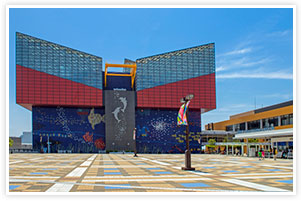
- Access
- Take the Subway Chuo Line from Bentencho Station on the JR Osaka loop line, alight at Osakako Station, and walk for 5 minutes.
- TEL
- +81-6-6576-5501
Kaiyukan is one of the largest aquariums in the world. The Kaiyukan's exhibition concept is based on the "Gaia Hypothesis". The “Gaia Hypothesis” is the brainchild of British scientist James Lovelock, which proposes that all organisms and their inorganic surroundings on Earth are closely integrated to form a single and self-regulating complex system. Centered around the Pacific Ocean tank, where you can see whale sharks (the world's largest fish) swimming, the aquatic life of the Pacific Rim is reproduced in 14 fish tanks. Walking through the Aqua Gate, resembling an undersea tunnel, is like walking beneath the ocean. After 5 p.m., the Kaiyukan shows a completely different face from the one it wears in the daytime. The adorable sleeping forms of sea otters and penguins. The scary face of a moray eel, something that can only be seen at night. Living things seen at night are - truly fascinating. On weekends the space in front of the Kaiyukan is filled with crowds gathered around the many street performers who come to show their acts.
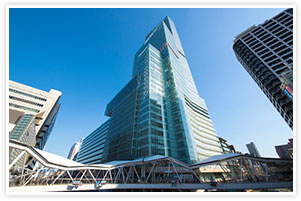
- Access
- Right in front of Tennoji Station on the Subway Midosuji Line / Tennoji-mae Station on the Hankai Denki Uemachi Line / Osaka Abanobashi Station on the Kintetsu Minami Osaka Line.
- TEL
- +81-6-6624-1111
The sixty-story, 300 m high skyscraper was the first super-tall building (global standard of 300 m or over) to be built in Japan, and remains the tallest. The lower floors contain a Kintetsu department store (Abeno Harukas Kintetsu Main Branch) and a museum (Abeno Harukas Art Museum), while the middle floors are occupied by offices and the upper floors are home to the Osaka Marriott Miyako Hotel and an observation deck. Abeno Harukas is conveniently located above one of Osaka's major regional transport hubs, a station with seven railway lines. Furthermore, Abeno Harukas can be directly accessed in about 30 minutes from both Kansai International Airport and Osaka International Airport. As a southern gateway of Osaka, Abeno Harukas is a new link to Asia and the whole wide world.
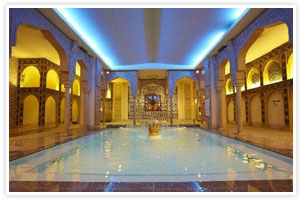
- Access
- Walk 2 minutes from the east exit of JR Shin-Imamiya Station. Walk for approx. 5 minutes from Exit No. 1 or 6 of Dobutsuen-mae Station on the Subway Sakaisuji Line / Midosuji Line.
- TEL
- +81-6-6631-0001
Take care of your beauty and health 24 hours a day at "SpaWorld Onsen from around the World". Relax and feel warm at this healing oasis in the middle of the metropolis. The entire facility is a natural spa theme park. There are all sorts of facilities to enjoy, including spas and pool zones that make you feel like you're off on a trip, and unique facilities that can't be seen in ordinary spas. Just opened are Spa Kids for families and Rock Baths of the World, with rock baths from eight different countries, for couples! Whether you are with the whole family or have come as a couple, you can spend your time in any way you want.
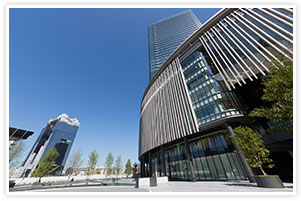
- Access
- Walk 9 minutes from JR Osaka Station / Subway Umeda Station / Hankyu Umeda Station. Walk 13 minutes from Hankyu Umeda Station.
- TEL
- +81-6-6440-3855
The forty-story 173 m tall Umeda Sky Building is at the core of Shin Umeda City. The key element of the world's first connected skyscraper is not only its eye-catching design, but also the fact that it contains so many attractions, such as a movie theater, restaurants, and spaces where events are held, all topped off by one of Osaka's most popular draws, the Floating Garden. The Umeda Sky Building is packed with so many enjoyable opportunities to play, eat, relax, see, watch, listen and learn that every visit is guaranteed to be well worth the time.
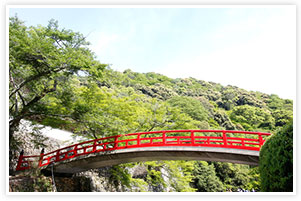
- Access
- Take the Hankyu Minoo Line from JR Osaka Station. Alight at Minoo Station. Walk north 400 m.
- TEL
- +81-72-721-3014
A picturesque natural park that covers the mountainous area to the north of Minoo City, between elevations of 100 to 600 m. The park was designated as a quasi-national park in commemoration of the 100th anniversary of the the beginning of the Meiji period. From Minoo Waterfall, which is considered to be one of Japan's "Tenka-no-Meibaku" (great waterfalls), a gorge winds through the forest like a sewing thread. The mighty roar of the grand Minoo Waterfall, 5 m wide and 33 m high, is a truly mystical sound, and the atmosphere all around is nothing short of divine. The hiking course along the gorge from the park entrance to the great waterfall is crowded with people all year round, and is the western starting point of the Tokai Nature Trail. The sakura in spring, frost-covered trees and icicles in winter, and of course the beautiful leaves changing color in late autumn all lend the scenery hues particular to their season. Mt. Minoo has long been a sacred place of Mountain Buddhism, and on the way to the waterfall you will see old temples like Ryuan-ji Temple (Minoo Temple), and also a konpon dojo (main training hall) established by mountaineering ascetic adherents to Shugendo. The monkeys who live in the park are very curious about what people are holding, and especially eating! They have been known to jump at people, so some caution is advised. Momiji-no-Tempura is a speciality of Minoo that tastes like karinto (fired sough cookies).
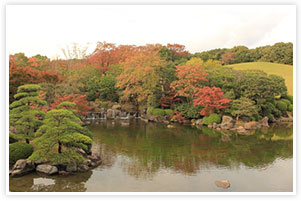
- Access
- Take the Subway Midosuji Line from JR Osaka Station. Take the Osaka Monorail from Senri Chuo Station. Walk 3 minutes from Banpaku Kinen Koen Station.
- TEL
- +81-6-6877-3339
Expo’70 Commemorative Park was built on the site of the Japan World Exposition (Osaka Expo). Located 15 km north of central Osaka. The extensive park of 264 hectares, i.e. about 65 times larger than the Koshien Baseball Stadium, has open areas, sports and cultural facilities. The theme pavilion and symbol of the Osaka Expo, the "Tower of the Sun", designed by Taro Okamoto, stands in the middle of the Natural and Cultural Gardens and is now an icon of Osaka to rank with Osaka Castle. In order to restore the natural environment after the pavilions had been removed, various trees, plants and flowers were planted on artificial ground west to the Tower of the Sun, and a natural forest and countryside landscapes were reproduced with the creation of several waterfalls and streams. The forest is very popular among citizens as a strolling course that changes with the seasons. Festivals and events are held often on the extensive lawn to the east of the Tower. The Japanese Garden within the park was originally a Japanese Government exhibit during the Expo, and provides people with the experience of Japanese elegant simplicity, wabi sabi”, through gardens created with various traditional Japanese gardening techniques.
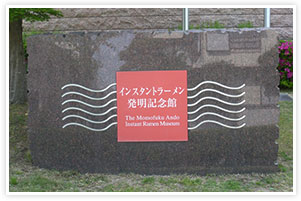
- Access
- Walk south for 5 minutes from the exit for Masumi-cho at Ikeda Station on the Hankyu Takarazuka Line.
- TEL
- +81-72-752-3484
The museum shows the footprints of Momofuku Ando, who in 1958 became the first person in the world to invent instant ramen, as well as showing all the history and changes which have occured in the world of instant ramen since. The shack in which Momofuku invented chicken ramen is replicated in the museum. You can make your own pack of original chicken ramen, too. You can also design your own cup, select the soup and toppings of your choice and make an original Cup Noodle at the My Cup Noodle Factory. There is a delicious ramen restaurant close by which was opened by a big fan of Momofuku.



















